GRT History Month: An Unfinished Painting
Whilst the origins of the below painting are somewhat shrouded in mystery, much can be learned from it (even in its unfinished state) about the lives of Gypsy, Roma and Traveller communities.
By exploring The MERL’s Bob Dawson Collection and the museum library, we have been able to identify the different aspects of Traveller life that this painting depicts. In this online exhibition, we highlight these through references to the painting and by featuring a range of related objects from our collections.
Much like the painting, The MERL’s representation of GRT communities has a strong foundation but is unfinished. There is much room to add depth and perspective to our practices. This is a starting point. From here, we hope to gather more personal stories, move away from stereotypical ideas, and make space in our collections for people whose lives have shaped, and continue to shape, the English countryside.

'Vardo'
'Grais'
'Juke'
'Cookerell'
Smock
'Bengree'
'Diklo'
The Painting
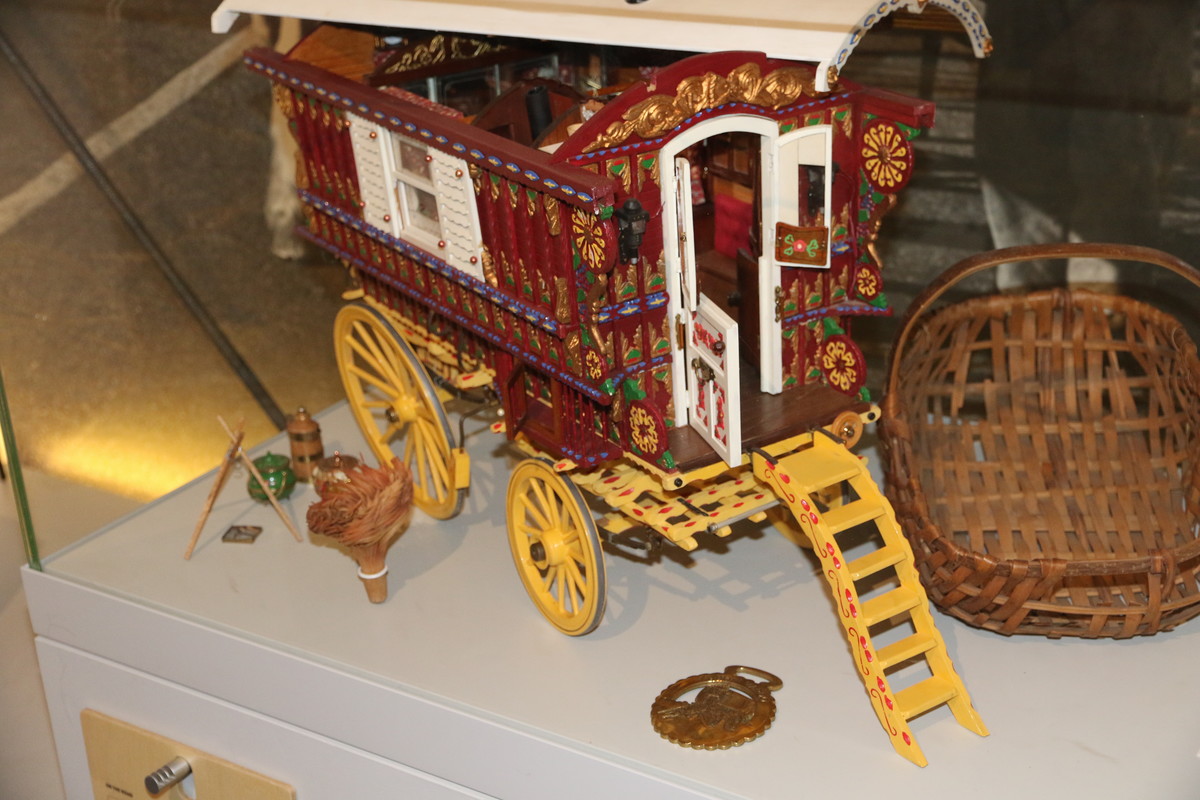
Vardo / Caravan
This model caravan (or, ‘vardo’ in the Romani language) was made by Ron White in 1995. White made all the parts, which took him between six to nine months, and it arrived at the museum together with a pack of plans which he used for its assembly. It is maroon and yellow with removable white shutters, and includes items such as pillows, pictures, and pots and pans. It features a separate mirror for viewing the undercarriage, as well as a lighting system.
The wheels of a vardo are made from one piece of wood. They are set in a position that raises the caravan high above the ground, allowing it to navigate terrain like fords and streams without risking the insides getting wet. Vardos are also wider at the top than the bottom, which allows for maximum elbow room inside and enables it to pass through narrow hedge-lined lanes without scratching its decorative paintwork.
In some cases, a vardo would be created from 365 pieces of wood, each symbolising a day of the year.
Travel is part of Gypsy, Roma and Traveller heritage. In 1968, the UK Parliament acknowledged this and set up several recognised sites to allow the Gypsies to travel continuously. However, an insufficient number of pitches were made, and 4,000 families struggled to find appropriate stopping places (‘aitchin tans’). The lack of room and constant harassment is a major problem, and could contribute as to why many have resorted to moving into houses today.
2007/21
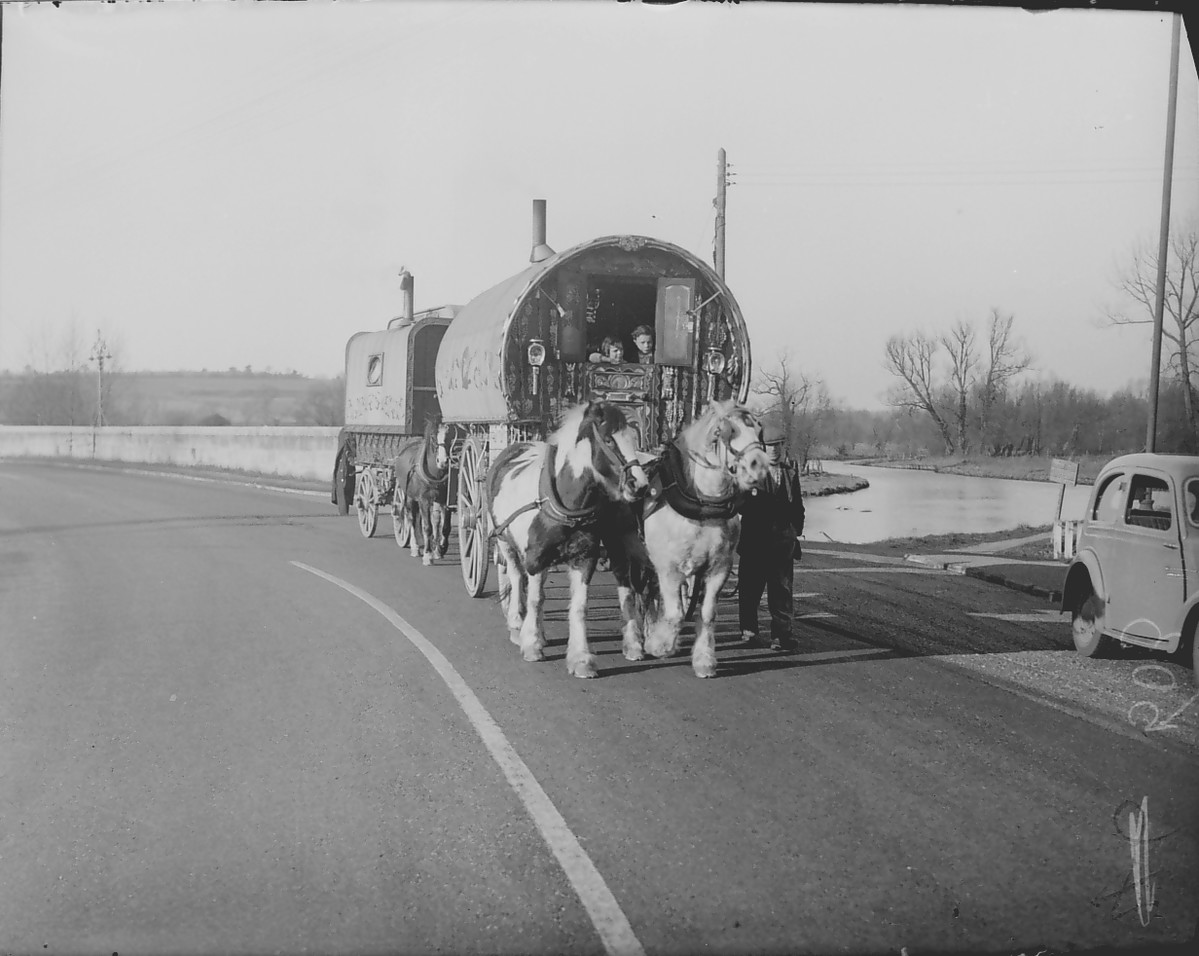
Grais / Horse
Horses have been a vital part of Traveller life. Although the reliance of horse-drawn vardos may have declined, horses are still kept by many families.
At one time, fairs like Lee Gap, Seamer and Topcliffe were all horse fairs where Travellers could showcase and sell horses, as well as socialise and ‘peddle’ goods to local people. Whilst many of these fairs have lost some of the traditional elements, fairs like Yarm, Appleby and Brough still go strong today.
One of the most famous horses associated with Travellers is the Gypsy Vanner of Gypsy Cob. These were bred with a distinctive piebald coat which would be white with black spots. They would have lots of feathering, which is the hair found around the horse’s ankles. These were bred to be strong but small, as well as particularly beautiful. It was recalled that during the First World War, when the army was commandeering horses, they would not take the Vanner due to its colouring.
P DX 289 PH1/503/1-2
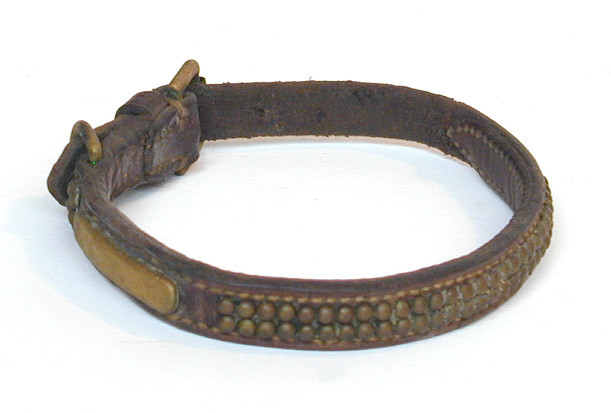
Juke / Lurcher
Lurcher ‘Juke’ or ‘Jukkal’
Lurchers are considered to have been created by Gypsies, who cross-bred greyhounds or whippets (for speed) and collies (for their agility and stamina). The lurcher was a vital part of the family and also contributed to dinners, by hunting hares, rabbits and even foxes. Lurchers are said to have a very calm temperament and are at home in the town or country.
55/152
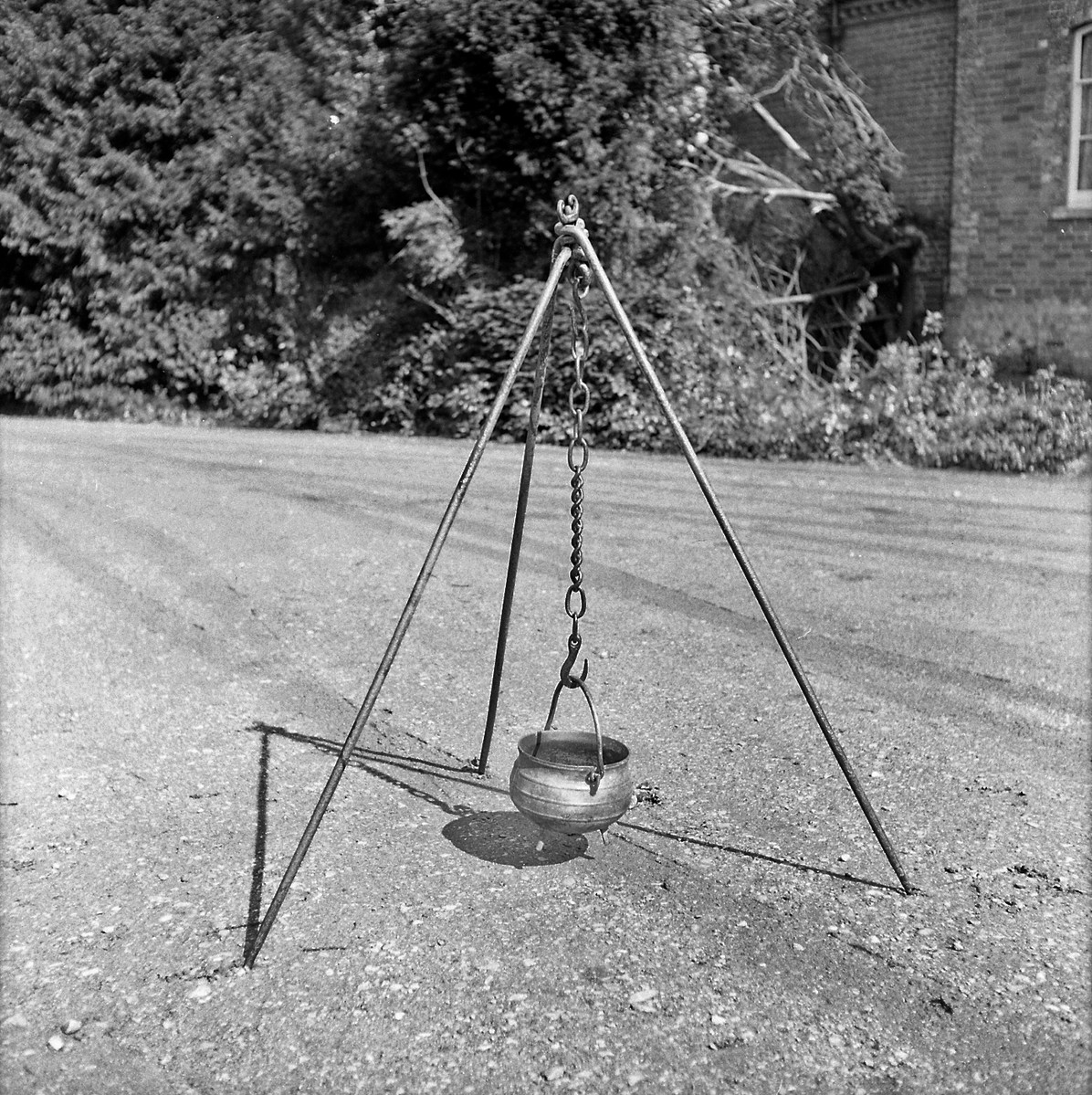
Cookerell / Cooking Pot
The large cooking pot formed the basis of all Gypsy cooking, and the fire (‘hatching tan’, meaning where the fire is lit) was the hub of family living. Upon arrival at a site, a fire would be lit, providing warmth and a shared area for socialising as well as cooking and brewing tea. Great care was taken to remove a piece of earth for the fire, which would then be replaced once the site was left.
Most meals contained foods that can be left to cook for long periods of time, and extensive knowledge went into preparing a hearty meal for many people. Slow-cooking foods would be added to the pot first, and the quicker-cooking items would be added throughout the day so they could all be removed and eaten at the same time.vii Meals were eaten in the late afternoon once work was complete and supplies from local shops had been purchased. Cooking has often been the job of a mother, and she would pass on family recipes to her daughter over time.
Once dinner was finished, the campfire provided a hearth for drinking tea, smoking, singing, and storytelling.
54/95/1-2
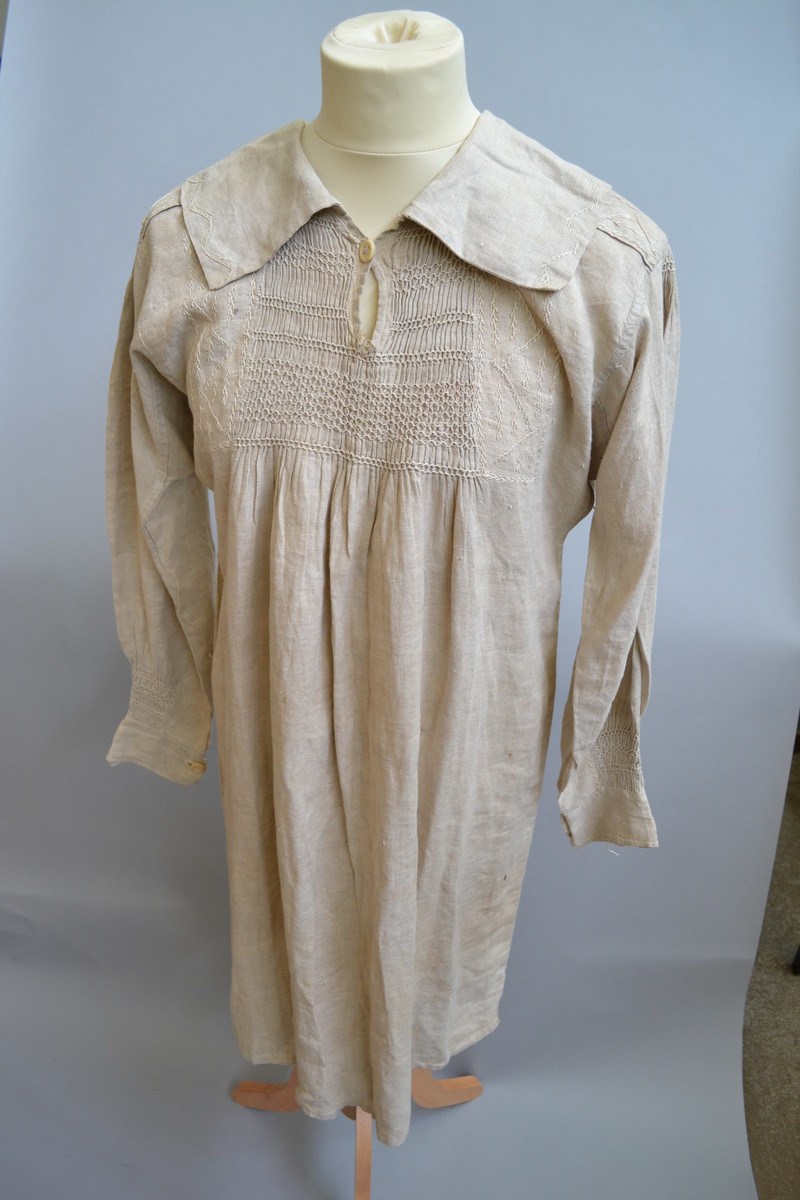
Smock
The shirt depicted in the painting reflects a long history of agricultural wear, spanning the history of clothing in rural England.
For centuries, smocks were worn by farm labourers, canal workers and builders, as they protected the wearer from the elements and allowed for free movement, which were both essential for labour-intensive work.
Historically, Traveller groups have often been employed in seasonal agricultural work, so it would be of no surprise if the smock style shirt was still a vital part of everyday wear long after they went out of mainstream fashion.
2019/391
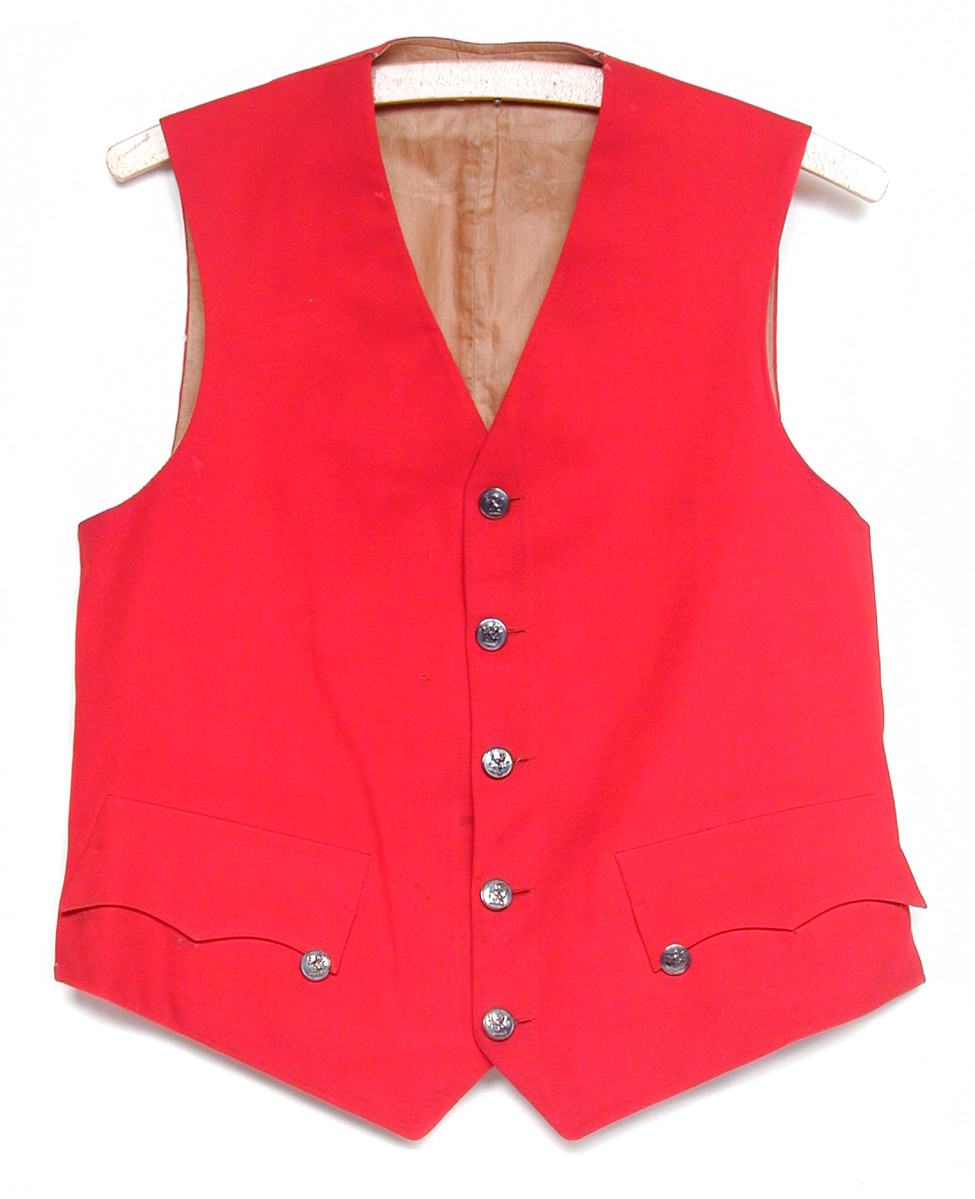
Bengree / Waistcoat
Despite the modern connotations of a waistcoat being suited for business attire, waistcoats were commonly worn by labourers and Navvies whilst undertaking heavy manual labour. They provided warmth when working in winter, but due to the lack of sleeves, still allowed for maximum movement, where a jumper or jacket would have been more restrictive. Colour choices varied, although red might have been a more unusual colour depending on the person. Red is translated to ‘lolli’ or ‘lollo’, and comes from the word for copper, relating to money, which has developed into the English slang word ‘lolly’ for money.
92/74
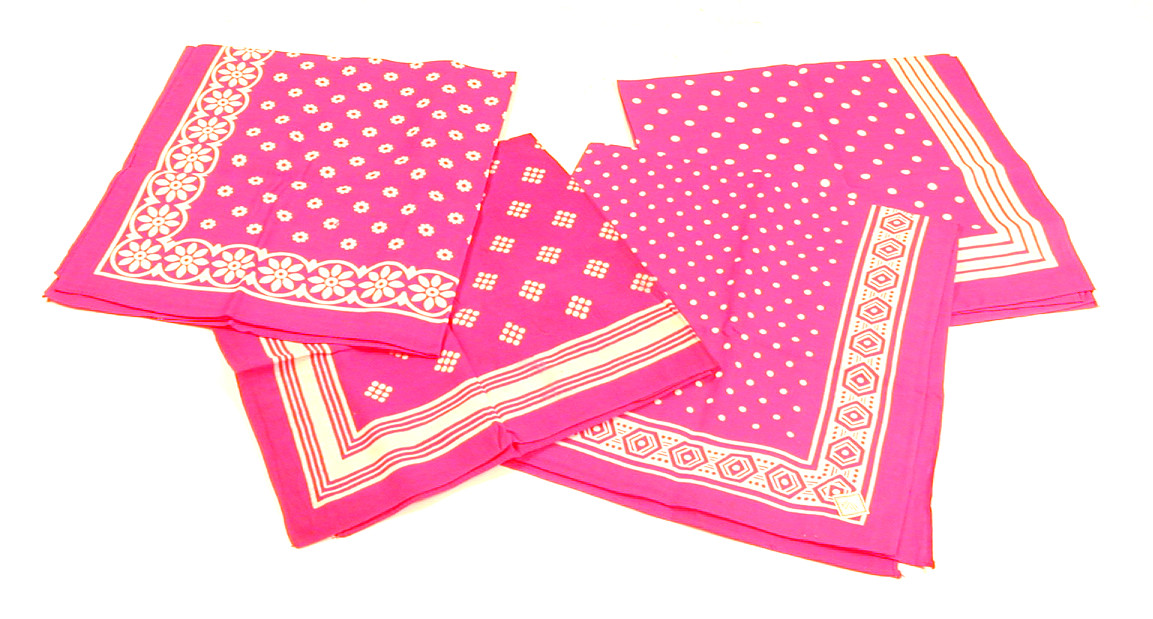
Diklo / Neckerchief
Neckerchief ‘Diklo’ or ‘Men Pangushi’ for neck-scarf
Neckerchiefs are again more traditional wear that were popular for agricultural workers and labourers. The cloth protected the wearer from the sun and wind, and was useful for collecting sweat during hot weather.
The style captured in this painting is similar to clothing from the early 1900s and before. However, this painting was made in the 1960s, which suggests the Gypsy people were still wearing more traditional clothing at that time. This mirrors the way that the clothing of canal folk was seen as outdated but remained in use because of its longevity, its suitability for work and domestic life, and its contribution to maintaining social customs.
97/37/1-4

Solve a Mystery...
The painting was commissioned between 1958-1960 by Dr Michael Stack-Dunne and depicts a group of Travellers, their horses, dogs and caravans. Upon donation of the item in 2011 it was unclear who the artist or the sitters for the image were. Stack-Dunne had ordered the painting upon an agreed fee and only asked that the painting be ‘3 x 5, Real Life’.
Stack-Dunne was able to recall that the female artist had regular employment at the Medical Research Council Laboratories at Holly Hill, Hampstead. He also believed that she knew the people that she painted.
After beginning work, the artist asked Stack-Dunne for further payment, but he was unable to cover these costs. So, it was agreed that the artist would send the painting in its unfinished state, as we see it here today.
It was hoped that whilst on display at the museum, either the artist or the sitters would recognise the image and shed light on to the story behind it. But these remain a mystery today.
MERL 2011/6